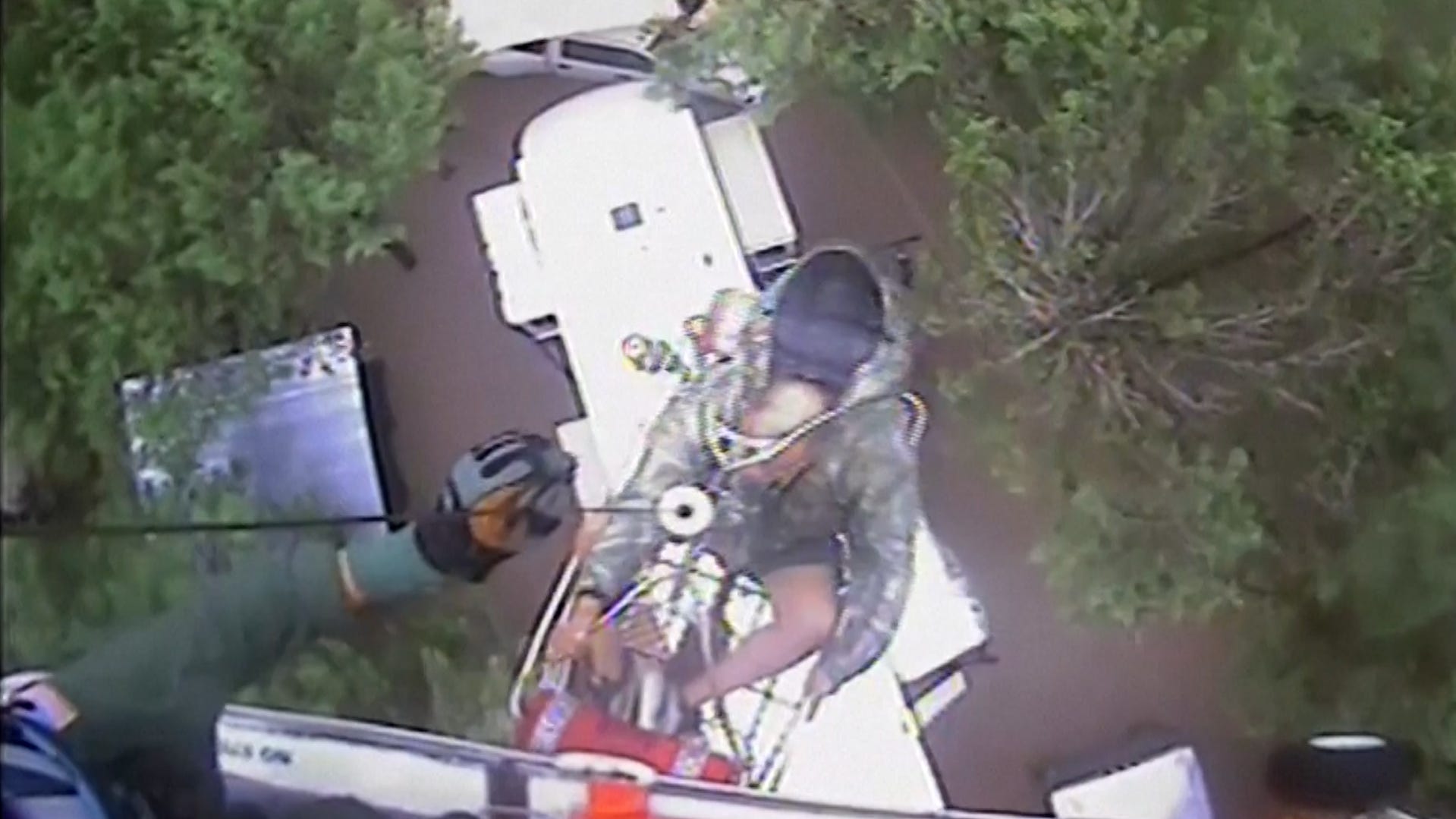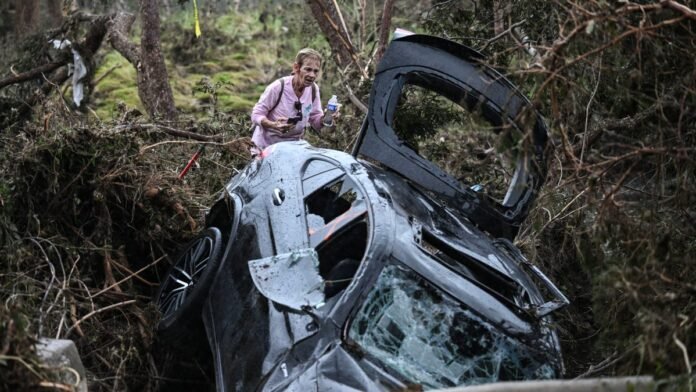The hilly terrain and the trickiness of predicting flash floods made forecasting – and alerting communities along the Guadalupe River in real time – particularly challenging.

Search for Texas flood survivors intensifies
A search for Texas flood survivors intensified as Texas Governor Greg Abbott issued a disaster declaration for nearly two dozen Texas counties.
- Meteorologists sensed a significant weather event brewing but the flash flood warnings came with little time to act.
- Predicting flash floods in hilly terrain and alerting communities promptly proved challenging.
- Despite early warnings and preparations, the speed and intensity of the floods caught officials and residents off guard.
- Over 10 inches of rain fell in just four hours, causing the Guadalupe River to swell dangerously.
They sensed something big was brewing.
Still, for the meteorologists and hydrologists tracking the weather patterns that led to the deadly Independence Day floods in the Texas Hill Country, the most urgent advisories weren’t deployed until it was almost too late, according to interviews and advisories.
Forecasters said they pushed out warnings as fast as they got the data. But the hilly terrain and the trickiness of predicting flash floods made forecasting – and alerting communities along the Guadalupe River in real time – particularly challenging.
“This is a problem that we are constantly trying to work on: how to better communicate,” Greg Waller, a hydrologist at the National Weather Service’s West Gulf River Forecast Center in Fort Worth told USA TODAY. “We can issue the best forecast in the world, but if it’s not put in the hands of the individuals so they can make the best decision, that forecast has little value.”
Authorities said on July 6 that at least 70 people have died in flooding triggered by unrelenting rain on the night of July 3 and into the early morning hours the next day. Sheriff Larry Leitha of Kerr County, where the worst of the flooding occurred, said search and rescue crews had recovered the bodies of 38 adults and 21 children.
Eleven children and a counselor from Camp Mystic, a Christian girls’ camp at the edge of the Guadalupe River, remained missing.
‘We didn’t know this flood was coming’
Local officials said they were caught off guard by the floods.
“We didn’t know this flood was coming,” Kerr County Judge Rob Kelly told reporters after the flood. “We had no reason to believe this was going to be anything like what’s happened here. None whatsoever.”
Moisture from Tropical Storm Barry, which slammed into Mexico in late June, drifted over Texas in the first few days of July, said Bob Fogarty, a meteorologist at the National Weather Service Austin/San Antonio office. There, it collided with an upper-level low pressure system, which parked it in place.
Then it began to rain.
Meteorologists at the center initially sensed that the combination of moisture and pressure could lead to heavy rain, but nothing particularly significant, Fogarty said.
As early as July 2, officials at the Texas Division of Emergency Management, or TDEM, were publishing news releases warning that “heavy rainfall with the potential to cause flash flooding is anticipated across West Texas and the Hill Country” and readying resources, such as swift-water rescue boat squads.
At 10 a.m. on July 3, NWS meteorologists joined a Zoom call with more than a dozen TDEM members and county emergency management officials from around Texas. It’s unclear whether Kerr County officials joined the call.
The focus of the call was the high moisture gathered over Texas and the possibilities of thunderstorms and heavy rain in the Hill Country, Fogarty and others on the call said.
Meteorologists predicted a “slight” risk – or level 2 out of 4 – for flash flooding. There were no predictions of catastrophic floods.
A few hours later, at 1:14 p.m., the NWS office released its first advisory: a “flood watch” for eight Hill Country counties, including Kerr. “Excessive runoff may result in flooding of rivers, creeks, streams, and other low-lying and flood-prone locations,” it warned. The advisory also predicted 1 to 3 inches of rain and up to 7 inches in some places.
A flash flood “watch” is less urgent than a “warning,” Fogarty said.
“The purpose of the watch is merely to get people aware that there may be bad weather coming,” he said. “We don’t really expect necessarily action on the watches.”
After the Zoom call, Texas emergency officials elevated its readiness level to “Level II (Escalated Response).”
‘It was a very saturated environment’
Waller, the hydrologist in Fort Worth, also listened in on the 10 a.m. Zoom call. His office is in charge of forecasting rising river levels. He said he was aware of the moisture and the potential for heavy rain, but initially nothing seemed too out of the ordinary.
Just after lunchtime, however, another hydrologist came into his office: He was alarmed at the level of moisture in the air and how heavy rains could swell the myriad rivers, creeks and tributaries of the Hill Country. Sensing something more ominous, Waller called in more staff to make sure the forecast center was staffed through the night.
“It was a very saturated environment,” Waller said. “It was not going to be a normal thunderstorm day.”
Meteorologists at the Austin/San Antonio office were also studying computer models and noticing a dangerous buildup of moisture and heavy rain. At 1:18 a.m. July 4, they upgraded to a “flash flood warning,” which triggers cell phone alerts to area residents.
Still, predicting where and how flash floods will occur is incredibly challenging, especially in terrain as hilly as the area around Kerrville, where water rushes down into ravines and could overwhelm riverside towns and campsites within minutes, said Chris Liesmann, emergency management coordinator for Blanco County, about 50 miles west of Austin.
In 2015, heavy rains caused the Blanco River to swell to 40 feet – higher than it’s ever been – within just a few hours, pushing homes off their foundations as it overran its banks and mauling towns. Those floods killed 13 people and destroyed hundreds of homes.
The speed and ferocity of the floods took everyone by surprise, he said.
“It happens very quickly,” Liesmann said. “It’s one of those things that you just have to do your best to try to get everybody notified. You just have to be watching and always thinking in advance.”
Meteorologists also rely on eyewitness accounts to confirm that a flood event is actually happening, Fogarty, the meteorologist, said. Flash floods are inherently harder to document, he said.
“If somebody gets hit with two-inch hail and it breaks the window in their car, they’ll call us and say, ‘I got hit by two-inch hail,’” he said. “But if there’s a flood, you’re trying to get out of the way of the flood – you’re not taking time to call it in.”
At around midnight July 3, rain began gushing into the Guadalupe River – dropping more than 10 inches into the river at Hunt in just four hours and swelling it to dangerous levels.
At 4:03 a.m., the NWS Austin office put out a “flash flood emergency” bulletin: “This is a FLASH FLOOD EMERGENCY for South-central Kerr County, including Hunt. This is a PARTICULARLY DANGEROUS SITUATION. SEEK HIGHER GROUND NOW!”
But for many who had gone to sleep that night unaware of the gathering threat, it was too late.
Follow Jervis on X: @MrRJervis.


























